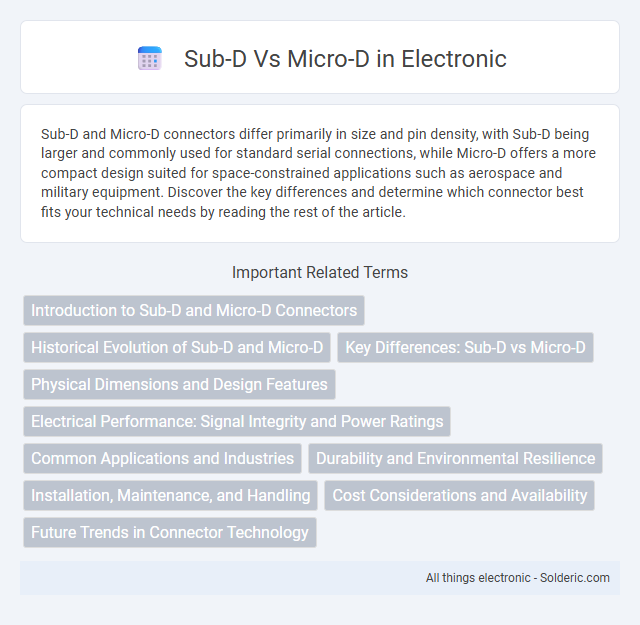Sub-D and Micro-D connectors differ primarily in size and pin density, with Sub-D being larger and commonly used for standard serial connections, while Micro-D offers a more compact design suited for space-constrained applications such as aerospace and military equipment. Discover the key differences and determine which connector best fits your technical needs by reading the rest of the article.
Comparison Table
| Feature | Sub-D | Micro-D |
|---|---|---|
| Description | Intermediate polygon subdivision modeling for smoother shapes. | High-detail subdivision technique for very fine surface tuning. |
| Use Case | General 3D modeling and animation workflows. | Precision modeling in film, gaming, and VFX industries. |
| Polygon Count | Moderate increase compared to base mesh. | Significant polygon increase for detailed control. |
| Control | Broad surface smoothing with fewer control points. | Fine-grained control over surface detail and curvature. |
| Performance | Less computational load, faster viewport response. | Higher computational demand, may reduce viewport speed. |
| Common Software | Maya, Blender, 3ds Max. | ZBrush, Mudbox, advanced Maya tools. |
Introduction to Sub-D and Micro-D Connectors
Sub-D and Micro-D connectors are widely used in electronic and communication equipment for reliable signal and data transmission. Sub-D connectors feature a D-shaped metal shell providing secure connections with various pin configurations, while Micro-D connectors offer a smaller, more compact design ideal for space-constrained applications. Your choice between these connectors depends on the required size, durability, and electrical performance for efficient system integration.
Historical Evolution of Sub-D and Micro-D
Sub-D connectors, originating in the 1950s, were initially designed for military and aerospace applications due to their robust construction and reliable signal integrity. Micro-D connectors emerged in the late 1960s to early 1970s as a miniaturized evolution of Sub-D, catering to the need for compact, high-density connections in space-constrained environments such as avionics and medical devices. Both connector types have continuously evolved with advancements in materials and manufacturing processes, maintaining their relevance in modern electronic systems.
Key Differences: Sub-D vs Micro-D
Sub-D connectors feature larger, more robust pins and are commonly used in computer and communication equipment for reliable, long-distance connections, while Micro-D connectors offer a smaller, high-density design ideal for space-constrained applications such as aerospace and military systems. Sub-D connectors typically range from 9 to 50 pins, providing versatility for various signal and power requirements, whereas Micro-D connectors support up to 100 pins with finer pitch, delivering higher signal integrity in compact assemblies. The choice between Sub-D and Micro-D depends on the balance between connector size, pin count, and environmental durability needed for specific electronic device designs.
Physical Dimensions and Design Features
Sub-D connectors typically feature a trapezoidal shape with a metal shell, available in various pin counts ranging from 9 to 50, and sizes from approximately 30 mm to 60 mm in width, offering robust mechanical durability. Micro-D connectors are smaller, with a rectangular shape and sizes generally under 10 mm in width, designed for high-density applications requiring lightweight and compact solutions. Your choice between Sub-D and Micro-D will depend on the available space and the need for a balance between size and connectivity performance.
Electrical Performance: Signal Integrity and Power Ratings
Sub-D connectors offer robust mechanical stability with moderate signal integrity suitable for standard data transmission, while Micro-D connectors excel in high-frequency applications due to their tighter contact spacing, enhancing signal integrity and reducing crosstalk. Micro-D connectors typically support higher power ratings per contact within compact sizes, making them ideal for aerospace and military applications where space and electrical performance are critical. Evaluating your system's signal requirements and power loads will guide the optimal choice between Sub-D and Micro-D connectors to maintain reliable electrical performance.
Common Applications and Industries
Sub-D connectors are widely used in computer interfaces, telecommunications, and industrial automation due to their robustness and ability to support multiple pins for complex signal transmissions. Micro-D connectors find common applications in aerospace, military, and medical devices where compact size and high reliability under extreme conditions are crucial. Both connector types serve critical roles in electronics, with Sub-D favored for bulkier, high-density connections and Micro-D preferred for lightweight, space-constrained environments.
Durability and Environmental Resilience
Sub-D connectors offer robust durability with metal shells that protect against physical stress, making them suitable for industrial and aerospace applications. Micro-D connectors, while smaller and lighter, maintain impressive environmental resilience through gold-plated contacts and sealed designs that resist moisture, dust, and vibration. Your choice depends on whether size constraints or extreme environmental durability is the priority.
Installation, Maintenance, and Handling
Sub-D connectors offer robust installation with screw-locking mechanisms that ensure secure, vibration-resistant connections, while Micro-D connectors feature push-pull locking for rapid mating and demating in compact spaces. Maintenance of Sub-D connectors involves routine inspection of pins and shells to prevent corrosion and ensure signal integrity, whereas Micro-D connectors require careful handling of delicate contacts and seals to maintain performance in miniaturized electronic applications. Handling Sub-D connectors demands moderate force and precise alignment due to their size, contrasting with the lightweight, ergonomic design of Micro-D connectors that facilitates easy integration in densely packed assemblies.
Cost Considerations and Availability
Sub-D connectors generally offer a cost advantage due to their widespread manufacturing and more robust design, making them suitable for applications requiring durability and multiple pin configurations. Micro-D connectors, being smaller and more specialized for aerospace and military use, typically incur higher costs and face limited availability in comparison. Procurement of Micro-D connectors often involves longer lead times and higher prices attributable to their precision engineering and niche market demand.
Future Trends in Connector Technology
Sub-D and Micro-D connectors will evolve with future trends emphasizing miniaturization, higher data transfer rates, and enhanced durability for extreme environments. Advances in materials and manufacturing techniques aim to improve signal integrity and reduce electromagnetic interference, making these connectors ideal for aerospace, military, and industrial applications. Your choice between Sub-D and Micro-D should consider upcoming integration with smart devices and IoT systems requiring robust, compact connections.
Sub-D vs Micro-D Infographic

 solderic.com
solderic.com